Summer Supper With a Tropical Twist
You don’t have to drive to the Carolina coast or fly to the Caribbean to indulge in a taste of paradise. For tropical flavor, bring the freshness of cool ocean breezes to your Triangle kitchen.
We’re not talking about mixing up those frou-frou drinks, like pina coladas, with mini umbrellas and maraschino cherries. (Although they certainly couldn’t hurt.)
Instead, we’re talking about feeling as if your beach hammock is gently swaying in the trade winds and the sun, sand and sea are right outside your door with these recipes from Brazil (salad) to Hawaii (dessert).
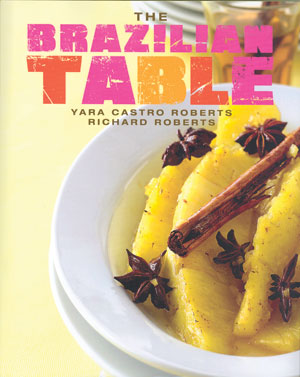 The Brazilian Table
The Brazilian Table
by Yara Castro Roberts and Richard Roberts
Published by Gibbs Smith
Ginger-Honey Salad
Ginger-Honey Dressing
4 teaspoons salt
2 teaspoons black pepper
2 tablespoons finely chopped fresh ginger
2 tablespoons honey
2 tablespoons orange juice
1/4 tablespoon olive oil
Salad
6 cups baby greens (lettuce, arugula, radicchio), washed and dried
1/2 cup roasted cashew nuts, coarsely chopped
In a mortar, pound together salt, pepper and ginger to make a paste. Add the honey and whisk together with orange juice and olive oil.
In a large serving bowl, toss the greens with 1/2 of the dressing. Sprinkle with the cashew nuts and pour the remaining dressing over the top.
Makes 6 servings.
Tropical Salad
Vinaigrette
4 teaspoons salt
2 teaspoons black pepper
2 tablespoons balsamic vinegar
1/4 cup olive oil
Salad
1 passion fruit (or bottled passion fruit juice)
3 cups French baby lettuce, washed and dried
1 cup watercress, washed and dried
2 teaspoons salt
1 cup sliced star fruit, persimmons or mango
2 tablespoons grated Brazil nuts
In a small bowl, combine salt, black pepper and balsamic vinegar. Whisk in the olive oil until it emulsifies. Reserve.
Cut the passion fruit in half. Place the pulp, including the seeds, in a strainer and press with a spoon. Collect the juice in a small bowl and reserve.
In a large bowl, mix the greens. Sprinkle salt and half of the passion fruit juice on the greens and toss gently.
Toss the salad with half of the salad dressing.
In a large, shallow bowl or on individual plates, place a few teaspoons of the passion fruit juice and the vinaigrette in the center of the plate. Arrange the salad in the center of the bowl and arrange the sliced fruit around the salad in a decorative pattern.
Sprinkle the grated Brazil nuts around the salad and top with the remaining vinaigrette.
Quick Bite
African culture has a decisive presence in Brazil. It was part of the past, it has sculpted the present and it has built a permanent path into the future. It is in the city of São Salvador de Bahía (known to all as simply “Salvador,” shown above), in the state of Bahía, that the wonderful African culture has blossomed in all aspects of life. It is here that we can see most directly how these African roots are at the core of the dishes of the region.
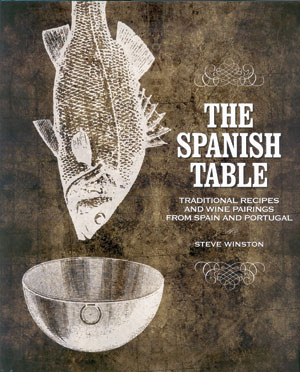 The Spanish Table: Traditional Recipes and Wine Pairings From Spain and Portugal
The Spanish Table: Traditional Recipes and Wine Pairings From Spain and Portugal
By Steve Winston
Published By Gibbs Smith
Fisherman’s Pot
This is a dish fishermen make out of the leftovers from their nights out on a wine-dark sea setting and pulling nets from a hand-oared dory — those brightly painted, sturdy wooden boats named after saints and wives that photographers love so much. It is nothing but the little fish left over after the restaurants and housewives have picked over their catch, plus a couple of potatoes and an onion. If you want it to taste to you the way it does to the fisherman, you need to drink a glass of brandy as an aperitif.
Olive oil
3 medium potatoes, thinly sliced, divided
1 large onion, thinly sliced, divided
1 pound small fish fillets, Dover sole or mixed species, divided (Preferably the smallest and least expensive available. Bottom fish are great.)
Pinch of Spanish sea salt
Pinch of freshly ground black pepper
1/2 cup Spanish extra virgin olive oil
1 tablespoon chopped parsley
Preheat oven to 350 degrees.
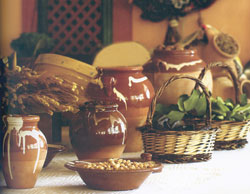
Oil the bottom of an 8-inch cazuela (see below - it’s a traditional clay pot). Cover the bottom with the slices of one of the potatoes, overlapping them like roof tiles. Add a layer of 1/3 of the onion, and then a layer of 1/3 of the fish. Dust with salt and pepper. Repeat twice until you have three layers. Pour the olive oil over the stack like pouring syrup over a stack ofhot cakes. Sprinkle with the parsley.
Bake 50 minutes while sipping your brandy.
Makes 2 servings.

 Mussels Steamed in Cava
Mussels Steamed in Cava
Seafood and sparkling wines not only belong together, but they are said, by people who should know, to have the components of an aphrodisiac. Therefore we suggest drinking the cava remaining in the bottle as this dish cooks. The recipe does not include garlic for obvious reasons. The decadent touch of the addition of shrimp meat adds complexity and color.
1 tablespoon olive oil
1/4 cup minced chives
12 green peppercorns packed in brine, rinsed and crushed with a pestle
1/4 teaspoon grated lemon zest
1/4 cup cava (Catalan white or pink sparkling wine)
1/8 pound shrimp meat
1/2 pound mussels, washed and de-bearded
Heat the oil in a medium cataplana (see below - it’s a hinged, domed pan that clamps closed to seal in moisture, much like two woks placed on top of each other and joined by a hinged lid) and stir in the chives, peppercorns, zest and cava, and heat just to a boil. Add the shrimp and mussels and clamp the lid of the cataplana closed. Cook 5 minutes, or until all the mussels are open.
Makes 2 servings.
Quick Bite
Prior to the European Union, Spain used the word “champana,” or in Catalan, “xampana,” for sparking wine. However, now words similar to “champagne” can be used only by the French. So today, sparkling wine from Spain is called “cava.”
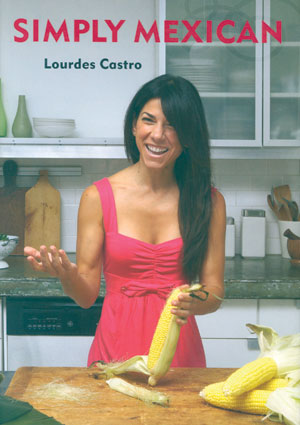 Simply Mexican
Simply Mexican
by Lourdes Castro
Published by Ten Speed Press
Chile-Smothered Shrimp Skewers
1-1/2 pounds large shrimp, peeled and deveined
1/3 cup Red Chile Paste (see recipe below)
3 tablespoons olive oil
Salt and black pepper
2 limes, each cut into 4 wedges
Cilantro sprigs, for garnish
Start by soaking eight wooden skewers. Thread the shrimp onto the skewers, leaving a small gap between each shrimp, which will allow them to cook evenly. You should be able to fit about four shrimp per skewer.
Place the shrimp skewers in a large, plastic freezer bag and spread the chile paste over the shrimp. Seal the bag, 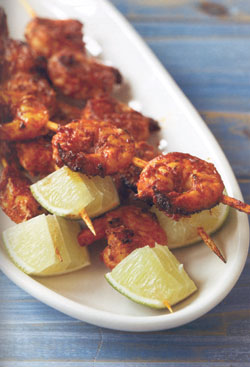 making sure to remove as much air as possible. Work the bag to evenly distribute the paste and rub it onto the shrimp. Place the bag in the refrigerator and allow the shrimp to marinate for 30 minutes.
making sure to remove as much air as possible. Work the bag to evenly distribute the paste and rub it onto the shrimp. Place the bag in the refrigerator and allow the shrimp to marinate for 30 minutes.
Remove the shrimp skewers from the freezer bag. Drizzle both sides of the shrimp with 2 tablespoons oil and season with salt and pepper.
Preheat a grill to medium-high for 10 minutes or preheat a grill pan over medium-high heat. Oil the grill pan or grill grates with the remaining oil. Grill the shrimp for 5 minutes on each side.
If sautéing, place a large sauté pan over medium-high heat and add the remaining oil. Add the shrimp skewers and cook for 5 minutes on each side. If the skewers do not fit in a single layer, sauté them in batches.
Spear a lime wedge onto the tip of each skewer. Place the shrimp skewers on a serving platter and top with sprigs of cilantro.
Makes 4 servings.
Red Chile Paste (Mexican Adobo)
4 dried ancho chiles
4 cloves garlic, unpeeled, but excess paper removed
1/8 teaspoon ground cinnamon
1 bay leaf, crushed
1/2 teaspoon ground cumin
1/2 teaspoon ground black pepper
1/2 teaspoon dried oregano
1 teaspoon salt
1/4 cup red wine vinegar
Cut or tear the chiles into flat pieces and remove the seeds and veins. Heat a nonstick skillet over medium heat and roast the chiles on both sides until they begin to release their aroma and soften up a bit, about 1 minute.
Transfer to a blender and fill with boiling water. Allow the chiles to soak for 30 minutes, making sure to keep them submerged under water.
Return the same skillet used to toast the chiles to the stove and place over medium heat. Add the garlic and roast, turning often, until the skin blackens and the garlic begins to smell toasty, about 10 minutes. Remove from the heat and peel. Set aside.
Pour the water out of the blender jar, leaving behind the rehydrated chiles. Add the garlic along with the cinnamon, bay leaf, cumin, pepper, oregano, salt and vinegar, and purée until smooth.
Transfer to a serving bowl if using right away, or transfer to an airtight container and refrigerate if storing.
Makes 1 cup.

Seared Tuna With Tomato and Roasted Corn Salsa
This recipe serves you summer on a dish. You will see how the tomato and roasted corn salsa pop right off the plate. While the salsa pairs beautifully with the tuna, feel free to pair it with your favorite fish or even chicken. Fast, fresh and easy — this will soon become your quick dinner fix.
 Kernels cut from 2 ears corn, or 1 cup frozen corn kernels, defrosted
Kernels cut from 2 ears corn, or 1 cup frozen corn kernels, defrosted
2 tablespoons olive oil
1/2 teaspoon salt, plus more to taste
Black pepper
1 cup cherry tomatoes, quartered
2 scallions, white portion only, chopped
1/4 cup lightly packed fresh cilantro leaves, chopped, plus more for garnish
1 avocado, pitted and chopped
2 limes
1 pound tuna steak
Cayenne pepper
Preheat the oven to 450 degrees. Prepare a baking sheet by lining it with parchment paper or aluminum foil.
Put the corn kernels on the baking sheet and toss with 1 tablespoon of the olive oil, 1/4 teaspoon of the salt and black pepper to taste. Spread the corn out evenly on the baking sheet and roast for 20 minutes. You want the corn to take on a golden brown color. It may seem that you have left the corn in the oven for too long, but you want the corn to caramelize and get a little crunchy. Remove the corn from the oven and set aside.
While the corn is roasting, combine the tomatoes, scallions, cilantro and avocado in a bowl. Finely grate the zest of 1 lime and add it, along with its juice, to the bowl. Toss well.
Once the corn is ready, toss it in the tomato mixture and season with 1/4 teaspoon of the salt. Taste and adjust the seasoning as needed. Set aside.
Using a paper towel, pat dry the tuna steak and season with a dusting of salt and cayenne.
Heat the remaining 1 tablespoon oil in a nonstick grill pan over medium-high heat. When the oil is hot, add the tuna and cook to medium-rare, turning once. The time it will take for the tuna to cook depends on its thickness. If you’re able to get a thick piece of tuna (about 1-1/2 inches thick), allow the tuna to sear for 4 minutes on each side for a medium-rare doneness. Thinner steaks will cook in less time. Ultimately, the tuna’s thickness and your preferred level of doneness will determine how long to cook the fish.
Cut the remaining lime into wedges. Serve the tuna along with the tomato and roasted corn salsa and garnish each serving with a lime wedge and sprigs of cilantro.
Makes 4 servings.
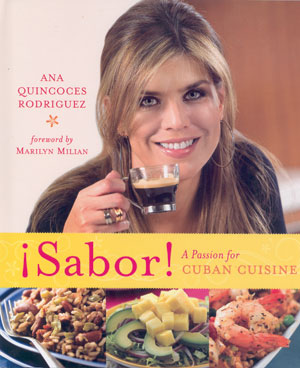 ¡Sabor!
¡Sabor!
A Passion for Cuban Cuisine
by Ana Quincoces Rodriguez
Published by Running Press
Platanitos Maduros (Fried Sweet Plantains)
There is nothing to this recipe, and yet it is somewhat complicated. The cooking is not the difficult part — all you do is peel, slice, and fry. No-brainer, right? The key is making sure you have the right plantain — it must be at the perfect stage of ripeness. You can do everything else right — peel it really well, slice it to perfection and fry it in the finest oil known to man. But without the right plantain, you have nothing! Ok, I know I’m being a little dramatic, but I can’t stress enough how the right plantain can make all the difference. So, I suggest going to a local Hispanic market and asking the sales clerk, the produce guy or any “seasoned” Cuban lady you can find to help you pick one out. My method is not foolproof, but here it is: ripe plantains are — well, not green. They are yellow and black, but mostly black. Basically, a ripe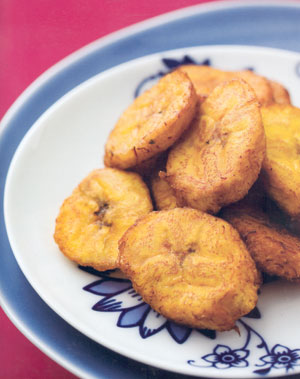 plantain is . . . how shall I put this . . . a rotting plantain. Rotting in that it is releasing its sugars, thereby making its skindark. So the darker, the better. That’s the best I can offer you. If you need more specifics, ask the guy at the store.
plantain is . . . how shall I put this . . . a rotting plantain. Rotting in that it is releasing its sugars, thereby making its skindark. So the darker, the better. That’s the best I can offer you. If you need more specifics, ask the guy at the store.
2 or 3 large ripe (black) plantains
2 or 3 cups corn or vegetable oil
Heat 2 to 3 inches of oil to 375 degrees in a large, heavy pot over medium-high heat.
Peel the plantains as you would a banana. Because they are soft, the skin will come off easily. Slice the plantains diagonally into 1-inch pieces. Carefully place 4 or 5 plantain slices into the hot oil and cook, turning only once, for 2 to 3 minutes on each side, until golden brown. Transfer the fried plantains to a paper towel-lined plate to drain, and continue with the remaining plantains. Serve immediately.
Makes 4-6 servings.
Boniato Frito (Fried Sweet Potatoes)
You know how people debate about whether pasta was invented by the Chinese or the Italians? Well, there is no doubt in my mind about who invented sweet potato fries — Cubans! Sweet potato fries only became popular in the U.S. in recent years, but Cubans have been making boniato frito for decades.
2 to 3 cups canola oil
2 pounds boniatos (sweet potatoes), cut into 1/4-inch-thick rounds or 1/4-inch-thick sticks
Coarse salt, optional
Heat 3 inches of oil to 350 degrees in a large, heavy-bottomed cast iron pot. Add the boniatos in small batches and fry them for 5 to 7 minutes, just until they begin to turn a light golden color. Transfer the fries to a paper-towel-lined platter. Allow the oil to come to 350 degrees, and continue with the remaining boniato.
Just before serving, heat the oil to 375 degrees, and fry the boniatos again, in batches, for 2 to 3 minutes, to crisp them up and make them a deeper golden color. Drain over paper towels and sprinkle with coarse salt.
Makes 4-6 servings.
 Family-Style Meals at the Hali’imaile General Store
Family-Style Meals at the Hali’imaile General Store
by Beverly Gannon with Joan Namkoong
Published by Ten Speed Press
Pineapple Upside-Down Cake
Located in the middle of pineapple fields on Maui, we simply must have a pineapple dessert at Hali’imaile General Store. For this nostalgic dessert, we use the Maui Gold, a low-acid sweet pineapple grown by Maui Land and Pineapple Company. This is just a simple, homey dessert but one that everyone loves. You can make this in a cake pan or individual ramekins — your choice.
1 large fresh pineapple
Caramel
3/4 cup butter
2 cups firmly packed light brown sugar
Cake
1-1/2 cups sugar
6 tablespoons butter
8 egg yolks
1/2 cup cake flour
1 tablespoon, plus 1/2 teaspoon baking powder
1/2 teaspoon salt
1 cup whole milk
2 teaspoons vanilla extract
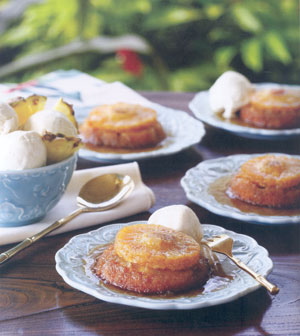 Preheat the oven to 300 degrees. Have ready a 9 X 13-inch rectangular baking pan or 9 (8-ounce) ramekins.
Preheat the oven to 300 degrees. Have ready a 9 X 13-inch rectangular baking pan or 9 (8-ounce) ramekins.
To prepare the pineapple, remove the skin and trim off the top and bottom. Slice the pineapple into 9 thick rings. Remove the core from each slice. If you are using ramekins, trim the pineapple rings to fit the ramekin. Set aside.
To make the caramel, in a saucepan over medium heat, melt the butter. Add the brown sugar and stir until the mixture becomes smooth. Remove from the heat and set aside.
To make the cake, in a large mixing bowl with a hand mixer, cream the butter and the sugar for 3 minutes. Add the egg yolks and mix for 1 minute on medium speed.
Sift the cake flour, baking powder and salt together. Add the flour mixture to the butter-sugar-egg mixture and mix on low speed to incorporate. Scrape down the sides of the bowl with a spatula and mix for another 30 seconds. Slowly add the milk, scraping down the sides of the bowl again. Add the vanilla and mix for another 30 seconds.
Spread the caramel evenly over the bottom of the pan or ramekins, leaving no empty spaces. Place the pineapple rings on top of the caramel. Pour the cake batter over the pineapple, leaving a 1-inch space from the top of the pan or 1/4 inch from the top of the ramekin.
Place the ramekins on a baking sheet; place the pan or the ramekins in the oven and bake for 35 minutes. Rotate the pan or ramekins and bake for another 10 minutes. Bake until the center of the cake is cooked or when a cake tester comes out clean. Remove from the oven, and cool for 5 minutes. Carefully invert the pan or ramekins and release the cake onto a serving plate.
Makes 9 servings.

 Vanilla Crêpes With Caramelized Bananas and Tropical Fruit Salsa
Vanilla Crêpes With Caramelized Bananas and Tropical Fruit Salsa
Dessert crêpes are one of my favorite things; they’re simple, elegant and easy to do. Make a batch of crêpes ahead of time and freeze them; pull them out and fill them with whatever fruits are available, or sauté them in butter with a flavored liqueur. Crêpes are light, not too sweet, and I think they’re coming back into fashion.
Fruit Salsa
1 mango, peeled, seeded and cut into 1/4-inch dice
1 strawberry papaya, peeled, seeded and cut into 1/4-inch dice
Half of a large pineapple, peeled, cored and cut into 1/4-inch dice
Caramelized Bananas
1/4 cup butter
1 cup firmly packed light brown sugar
1 tablespoon cinnamon
10 bananas, peeled and cut into 1/2-inch slices
Crêpes
1-1/2 cups milk
3 egg yolks
2 tablespoons vanilla extract
1-1/2 cups flour
2 tablespoons sugar
1/2 teaspoon salt
5 tablespoons butter, melted
To make the salsa, in a medium bowl, mix the mango, papaya and pineapple together. Cover and refrigerate until ready to serve.
To caramelize the bananas, in a skillet over medium heat, melt the butter. Add the brown sugar and cinnamon. Cook until the butter and sugar blend together and becomes creamy; do not boil, which will cause the butter to separate. Add the bananas and cook for 1 minute, stirring constantly. Remove from the heat and set aside.
To make the crêpes, in a large bowl, whisk together the milk, egg yolks and vanilla. Stir in the flour, sugar, salt and melted butter and mix until well blended.
Heat a 12-inch sauté pan over medium heat until hot. Lightly coat the pan with oil. Pour 1/4 cup of the batter into the pan, immediately tilting and swirling the pan to cover the entire bottom surface of the pan.
When the crêpe starts to bubble and the edges start to brown, loosen the edges with a spatula and flip the crêpe over. Cook the crêpe for an additional minute, or until lightly browned. Transfer the crêpe to a plate. Repeat with the remaining batter.
Divide the caramelized bananas evenly among the crêpes, fold or roll into desired shape, and place 2 on a serving plate. Top with fruit and serve.
Makes 6 servings.
Quick Bite
On the road to Kaleakala, Maui’s most famous volcano, you’ll drive through dense sugarcane and rolling pineapple fields to reach one of the island’s most popular dining destinations -– Hali’imaile General Store. Chef Beverly Gannon has welcomed visitors and residents alike with a laid-back atmosphere and a top-flight menu since 1988.
